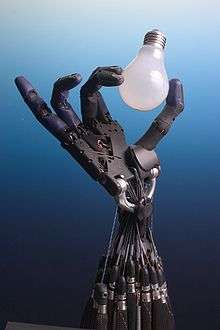Synthetic intelligence
Synthetic intelligence (SI) is an alternative term for artificial intelligence which emphasizes that the intelligence of machines need not be an imitation or in any way artificial; it can be a genuine form of intelligence.[1][2] John Haugeland proposes an analogy with simulated diamonds and synthetic diamonds—only the synthetic diamond is truly a diamond.[1] Synthetic means that which is produced by synthesis; combining parts to form a whole, colloquially, a man-made version of that which has arisen naturally. As defined, a "synthetic intelligence" would therefore be man-made, but not a simulation.
Definition
The term was used by Haugeland in 1986 to describe artificial intelligence research up to that point,[1] which he called "good old fashioned artificial intelligence" or "GOFAI". AI's first generation of researchers firmly believed their techniques would lead to real, human-like intelligence in machines.[3] After the AI winter, many AI researchers chose to focus on finding solutions for specific individual problems, such as machine learning, rather than artificial general intelligence. This approach to AI is referred to by some popular sources as "weak AI" or "applied AI".[4] The term "synthetic AI" is now sometimes used by researchers in the field to separate their work using subsymbolism, emergence, Psi-Theory, or other relatively new methods to define and create "true" intelligence from previous attempts, particularly those of GOFAI or weak AI.[5][6]
Sources disagree about exactly what constitutes "real" intelligence as opposed to "simulated" intelligence and therefore whether there is a meaningful distinction between artificial intelligence and synthetic intelligence. Russell and Norvig present this example:[7]
- "Can machines fly?" The answer is yes, because airplanes fly.
- "Can machines swim?" The answer is no, because submarines don't swim.
- "Can machines think?" Is this question like the first, or like the second?
Drew McDermott firmly believes that "thinking" should be construed like "flying". While discussing the electronic chess champion Deep Blue, he argues "Saying Deep Blue doesn't really think about chess is like saying an airplane doesn't really fly because it doesn't flap its wings."[8] Edsger Dijkstra agrees that some find "the question whether machines can think as relevant as the question whether submarines can swim."[9][10]
John Searle, on the other hand, suggests that a thinking machine is, at best, a simulation, and writes "No one supposes that computer simulations of a five-alarm fire will burn the neighborhood down or that a computer simulation of a rainstorm will leave us all drenched."[11] The essential difference between a simulated mind and a real mind is one of the key points of his Chinese room argument.
Daniel Dennett believes that this is basically a disagreement about semantics and that it is peripheral to the central questions of the philosophy of artificial intelligence. He notes that even a chemically perfect imitation of a Chateau Latour is still a fake, but that any Vodka is real, no matter who made it.[12] Similarly, a perfect, molecule-by-molecule recreation of an original Picasso would be considered a "forgery", but any image of the Coca-Cola logo is completely real and subject to trademark laws. Russell and Norvig comment "we can conclude that in some cases, the behavior of an artifact is important, while in others it is the artifact's pedigree that matters. Which one is important in which case seems to be a matter of convention. But for artificial minds, there is no convention."[13]
Notes
- Haugeland 1985, p. 255.
- Poole, Mackworth & Goebbel 1998, p. 1.
- Haugeland 1985, p. 3.
- "Artificial Intelligence - strong and weak". I Programmer.
- Imagination Engines, Inc., Home of the Creativity Machine
- Principles of Synthetic Intelligence: PSI : an Architecture of Motivated ... - Joscha Bach - Google Books
- Russell & Norvig 2003, p. 948.
- McDermott 1997.
- Dijkstra 1986.
- "How Intelligent is Deep Blue?". Retrieved 15 March 2019.
- Searle 1980, p. 12.
- Dennett 1978, p. 197.
- Russell & Norvig 2003, p. 954.
References
- Dennett, Daniel (1978), Brainstorms: Philosophical Essays on Mind and Psychology, The MIT Press, ISBN 978-0-262-54037-7.
- Dijkstra, Edsger (1986), Science fiction and science reality in computing
- Haugeland, John (1985), Artificial Intelligence: The Very Idea, Cambridge, Massachusetts: MIT Press, ISBN 978-0-262-08153-5.
- Law, Diane (1994), Searle, Subsymbolic Functionalism and Synthetic Intelligence (PDF).
- McDermott, Drew (14 May 1997), "How Intelligent is Deep Blue", New York Times.
- Russell, Stuart J.; Norvig, Peter (2003), Artificial Intelligence: A Modern Approach (2nd ed.), Upper Saddle River, New Jersey: Prentice Hall, ISBN 0-13-790395-2.
- Poole, David; Mackworth, Alan; Goebel, Randy (1998), Computational Intelligence: A Logical Approach, New York: Oxford University Press, p. 1.
- Searle, John (1980), "Minds, Brains and Programs", Behavioral and Brain Sciences, 3 (3): 417–457, doi:10.1017/S0140525X00005756, archived from the original on 23 August 2000.
External links
- What Is AI? – An introduction to artificial intelligence by John McCarthy—a co-founder of the field, and the person who coined the term.
- The Handbook of Artificial Intelligence Volume Ⅰ by Avron Barr and Edward A. Feigenbaum (Stanford University)
- "Artificial Intelligence". Internet Encyclopedia of Philosophy.
- Thomason, Richmond. "Logic and Artificial Intelligence". In Zalta, Edward N. (ed.). Stanford Encyclopedia of Philosophy.
- AI at Curlie

